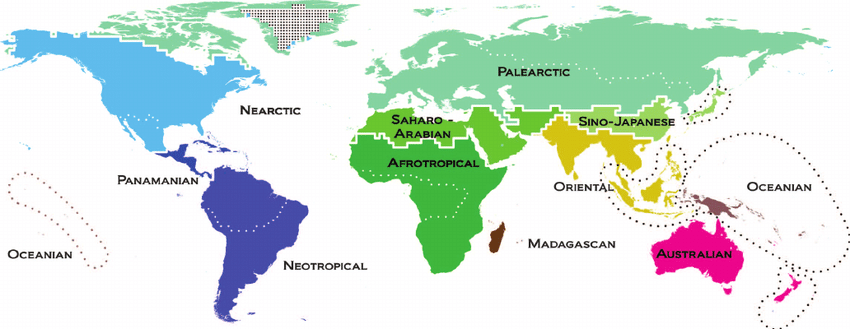Zoogeography and Habitat Adaptations
Fish Distribution Patterns
Divison of Regions: FW and Marine
58% MARINE
41% Fw
MARINE:
Epiplegaic: surface-200m
1.3% of total species
Deep pelgaic fishes: 1400 species
Mesoplegaic: 200-1000m
Bathypelagic: deeper than 1000m
Deep Benthic:
6.4% of species
Littoral.contential shelf fishes:
Inhabit the shore and shelf above 200m
45%
Freshwater:
Higher diversity: 1 species by 15km3 of water
Higher likelihood of genetic isolation
More energy available to support food webs
DIVISION:
FW Primary: strictly confined to FW
Disbtution not through dispersal
Secondary FW: may occasionally enter salt
Peripheral FW: spend part of their lifecycle in fresh and salt water
Islands with FW species have secondary and peripheral species; primary species could not have bene disbtuuited through dispersal because they are intolerant to salt water
Marine Zoogeographic Regions:
Indo-West Pacific: most diverse
⅓ of species of shallow marine fishes
Western Atlantic
Eastern PAcific
Eastern Atlantic
Regions separated by Continents
Species richness in tropic areas
Dispersal: Typical pattern of fishes traveling and speciation occurring
occurs Across preexisting barriers that are not easily re-crossed
Ex: Sheepshead minnow (Cyprinodon vareigatus)
Ability to colonize many habitats by dispersing many miles across ocean waters
Ability to tolerate wide ranges of salinity
Freshwater Zoogeographic Regions:
Neartic
Neotropical
Afrotropical
Indo-Malay
Australian
Paleartic

Non-Dispersal Distributon
Present distribution= influenced by past arraignments of continents
Pangea: 430 mya
Movement between regions was easier due to the connection
Began to break apart 130 mya
Vicariant Events: tectonic, climatic, or oceanographic occurrences that isolate previously connected populations
Ex: continental drift and species of lungfishes
Dominant mod, esp in fw fishes
S. tritor(spnasih mackerels): sister species to the rest of the mackerel group
Located in africa
Other makreles are spread globally
NA Mackerel: Scomberomorus maculatus
Special Habitats
Fishes have colonized any ecosystem with some permanence or predictability
Principle of Convergence: the stronger the selection pressure, the more similar unrelated species will be
Extreme habitats are colonized to gain comptieitve advantage
THE DEEP SEA:
Occurs in a vertical basis
Characteristics:
Photophores: light emitting organs
Large mouth w/dagger like teeth
Enlarged tubular eyes/ or reduced eyes
Chin barbels
Dorsal fin rays modified as lures
Convergent evolution among species
Ecological Pressures:
Pressure:
Fishes made up of incompresible structures = water with dissolved compounds
Insensitive to pressure proteins
No gas bladder/ adjusted lipid filled gas bladder
Rete mirabile: Capillary network involved in gas secretion into the bladder
Or Physoclistous
Temperature
Strong predictor of vertical distribution due to perm. thermocline
Only a stressor to fish that move vertically
Space: large volume makes it difficult to find food, conspecifics, and mates
Sexual dimorphism
Ex: Male Anglerfish: dwarfed, sensitive olfactory organs and extensive red muscle, enlarged eyes, high lipid reservers
Ex: bristlemouths; smaller males, but are protandrous hermaphrodites
Light:
Modified eyes that are sensitive to light
Biolumnescence: evolved independently in 5 superorders
Food: food is scarce-> all marine food chains originate in the euphotic zone
Deep sea fishes carnivorous
Large mouths to make sure they can take advantage of any feeding opportunity
Food attraction by lures and energy conserved as much as possible
Mesopelagic fishes: vertical migration to feed at night
POLAR REGIONS
Anatartic Water Temperatures: -2, 2C)
Antarctic notothernoids: antifreeze compounds in blood; will not freeze down to -6C
Cannot tolerate high temps-> means they are endemic
Artici Fishes: fewer endemic species
Most are cold tolerant atlantic or pacific species
Antifreeze compounds and production
Production adjusted by tempes
Toleration of temps -2 to 20 C
ARID
Desert fishes
Must be tolerant to extreme salinity, alkalinity, temp and depltted OD
Withstand flashfloods and droughts
Adaptions:
Life history with diapause(hiberation) during dry period
Diapause is integrated into the lifecycle
EX: Cyprinodontiforms, Austrofunduls myseri
Eggs are stored for a year in the soil
Accessory respiratory structures for using atm O2
Estivation: where adults pass the dry season
Ex: Clarias catfish
HIGH ENERGY ZONES
Wavy shoes, rapids in rivers, streams, waterfalls
Adaptions:
Depressed small body; flattened ventral surface
Suction device
Subterminal or inferior mouth
Missing swim bladder
Modofiications to respiratory behavior
Large, horizontally oriented pectoral fins
Ex: Waterfall climbing Sirajo goby
CAVES:
Advantages: little to no compeptiors, predators, and constant moderate climate
Disadvanges: no light, infreqnet food
Adaptations:
Lack of Pigmentation
Reduced squamation
Loss of light receptors (blind)
Expanded lateral line and chemoreceptors
Will consume more and build large fat supply when given unlimited food; adaptions to irregular food supply
Producer fewer, larger eggs, long parental care, low reproductive rates
EX: CRYPTOROA THAMICOLA
Waterfall climbing fish
Has the adaptions for cave fishes and fishes living in high-energy enviroments